Dzerzhinsk, Russia
Dzerzhinsk (Russian: Дзержинск, IPA: [dʲzʲɪˈrʐɨnsk]) is a city in Nizhny Novgorod Oblast, Russia, located along the Oka River, about 370 kilometers (230 mi) east of Moscow and 35 kilometers (22 mi) west of Nizhny Novgorod. Population: 240,742 (2010 Census);[3] 261,334 (2002 Census);[8] 285,071 (1989 Census).[9]
Dzerzhinsk Дзержинск | |
|---|---|
City | |
 | |
 Coat of arms | |
Location of Dzerzhinsk 
| |
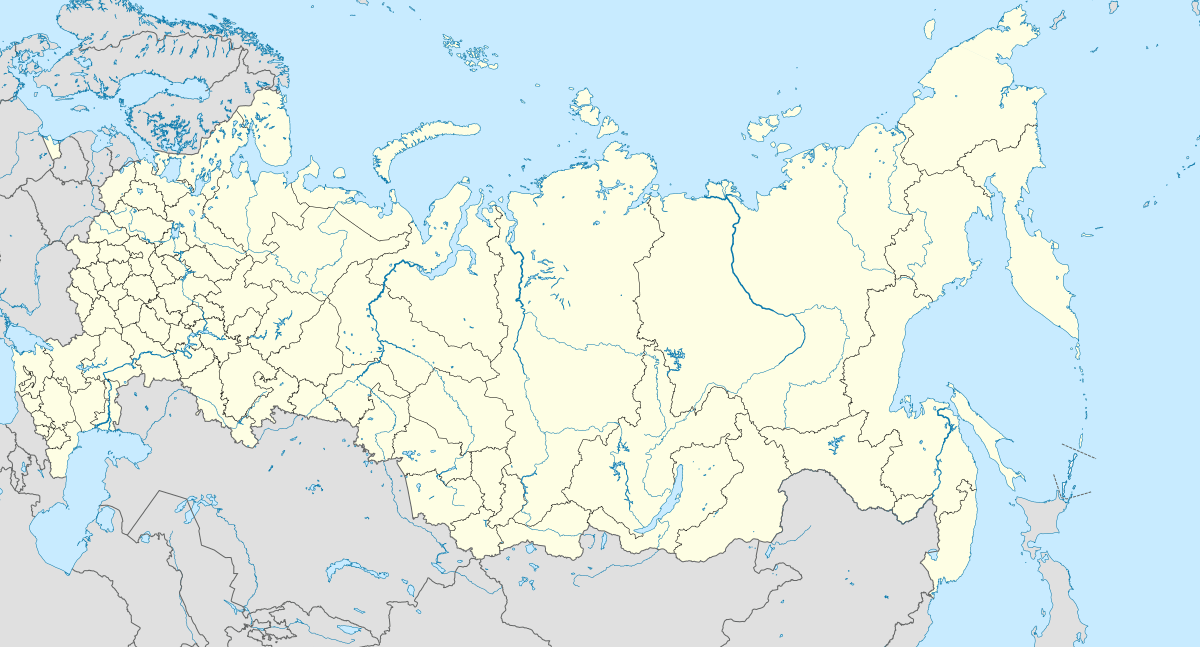 Dzerzhinsk Location of Dzerzhinsk .svg.png) Dzerzhinsk Dzerzhinsk (Nizhny Novgorod Oblast) | |
| Coordinates: 56°14′N 43°27′E | |
| Country | Russia |
| Federal subject | Nizhny Novgorod Oblast[1] |
| First mentioned | 1606 |
| Government | |
| • Mayor | Ivan Noskov[2] |
| Elevation | 90 m (300 ft) |
| Population | |
| • Total | 240,742 |
| • Estimate (2018)[4] | 230,639 (-4.2%) |
| • Subordinated to | city of oblast significance of Dzerzhinsk[1] |
| • Capital of | city of oblast significance of Dzerzhinsk[1] |
| • Urban okrug | Dzerzhinsk Urban Okrug[5] |
| • Capital of | Dzerzhinsk Urban Okrug[5] |
| Time zone | UTC+3 (MSK |
| Postal code(s)[7] | 606000—606039 |
| Dialing code(s) | +7 8313 |
| OKTMO ID | 22721000001 |
| City Day | Last Sunday of May |
| Website | www |
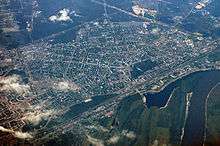
It was previously known as Rastyapino (until 1929).[10]
History
First mentioned in 1606 as Rastyapino (Растя́пино), it is named after Felix Dzerzhinsky, a Bolshevik leader who was the first head of the Soviet Cheka (secret police), since 1929.[10]
Administrative and municipal status
Within the framework of administrative divisions, it is, together with three work settlements and eleven rural localities, incorporated as the city of oblast significance of Dzerzhinsk—an administrative unit with a status equal to that of the districts.[1] As a municipal division, the city of oblast significance of Dzerzhinsk is incorporated as Dzerzhinsk Urban Okrug.[5]
Chemical weapons and other production
Modern-day Dzerzhinsk is a large center of the Russian chemicals production industry. In the past, the city was also among Russia's principal production sites for chemical weapons. Owing to its strategic significance, this city was, until recently, officially closed to foreign visitors.
Manufacture of various chemical weapons started in 1941, particularly concentrating on the production of lewisite—the poisonous effects of which are owed to its arsenic trioxide content—and yperite (mustard gas). The factory producing these substances was called the Kaprolactam (or Caprolaktam) Organic Glass Factory, and in addition to its arsenic-based weapons, also produced prussic acid and phosgene.
Chemical weapons production at Dzerzhinsk ceased in 1965. Some materials were transferred to storage units, while large amounts of waste material—frequently containing high concentrations of arsenic—were buried in dumps on the site of the factory. Full dismantling of the yperite facility was commenced in 1994. As of 1998, the lewisite production unit was still not completely disassembled.
As of 2008, Dzerzhinsk had 38 large industrial enterprises, which export their goods worldwide. About one thousand varieties of chemical products are produced in Dzerzhinsk. The largest factories, which exist as of 2012 or existed in the past, include:
- Sverdlov Plant, FSE (Federal State Enterprise) manufactures munitions, battle and industrial explosives, and chemicals for industrial purposes (phenol-formaldehyde resin, epoxy resin, carbamide-furane resin, plasticizers, hardeners of various modifications, nitrobenzene, sulphanole, acetic anhydride, various cleaners and detergents, as well as other products). The plant is included in the presidential list of the country's strategic enterprises. This is Dzerzhinsk's largest factory.
- JSC Kristall Research Institute, a military explosives factory, part of the Sverdlow Plant, which suffered a serious explosion in June 2019.[11]
- Korund, JSC (opened in 1915, the first factory in Russia to produce cyanide, still operational). This plant produces corundum for lasers and other applications. It is the oldest enterprise in Dzerzhinsk. In 2004, the plant was temporarily closed due to bankruptcy.
- Dzerzhinskhimmash, JSC (opened in 1941, currently (2013) makes distillation and сolumn equipment, evaporators, heat exchangers).
- Sintez, JSC. Produces acetone, carbonyl iron, diethanolamine, isopropanol, methylamine, phenol, etc.
- Orgsteklo, JSC (previously manufactured specialist glass for the aeronautics market, currently (in 2012?) specializes in production of acrylic co-polymers and organic glasses).
- Avangard-KNAUF, JSC
- Liebherr, JSC
- Plastik, JSC
- Aviabor, JSC
- SIBUR-Neftekhim, JSC
- Oka, Yava, Orgsitilen, Zarya (no longer functioning).
Pollution
According to the September 12, 2007, study by the Blacksmith Institute, Dzerzhinsk is one of the worst-polluted cities of the world and has a life expectancy of 42 years for men and 47 for women, with the 2003 death rate exceeding its birth rate by 260%.[12] Environmental action groups such as Greenpeace attribute such low life expectancy to high levels of persistent organic chemicals, particularly dioxins. The Blacksmith Institute also names sarin, lewisite, sulfur mustard, hydrogen cyanide, phosgene, lead, and organic chemicals among the worst pollutants.[12] Parts of Dzerzhinsk's water are contaminated with dioxins and phenol at levels that are reportedly seventeen million times the safe limit.[12]
Dzerzhinsk's environmental agency estimates that almost 300,000 tons of chemical waste were dumped in the city between 1930 and 1998. The Ecology Committee of the Russian State Duma also considers Dzerzhinsk among the top ten cities with disastrous ecological conditions.[13]
Dzerzhinsk's City Administration, however, asserts that the Blacksmith Institute report is false, stating, for example, that since sarin had never been produced in the city, it cannot be one of the major pollutants. Also, according to the city's health department, the average life expectancy in the city was 64 years in 2006. Askhat Kayumkov, the head of the Dront public ecological organization, which was quoted as a source by the Blacksmith Institute, states that his organization never provided the Blacksmith Institute with data of any kind. Furthermore, he does not believe that Dzerzhinsk is one of the most polluted cities in Russia, much less in the whole world.[14]
Additionally, a 2000 audit report by the Audiekometal organization, based in Moscow, asserted that, for the previous ten years, Dzerzhinsk had not made it to the top ten most polluted cities of the Russian Federation, and that the level of pollution in the city was "moderate".
In the end, however, despite the ecological situation in the city being at its best in the previous 80 years (mostly due to bankruptcies and closures of the polluting factories), several locations in the city pose a tangible ecological risk. These sites include the landfill, toxic waste burial grounds, and a so-called "white sea", composed of disposed chemical wastes.[15] These sites are kept under constant ecological monitoring.
In June 2019 a massive explosion at JSC Kristall Research Institute injured 79 people and destroyed 180 homes in the neighbourhood.[16]
Sights
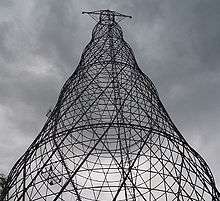
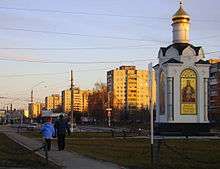
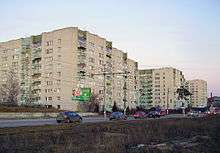
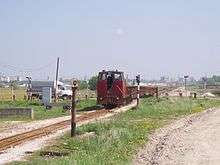
Shukhov Tower on the Oka River, the unique architectural construction—the 128-meter (420 ft) steel lattice hyperboloid tower built by Soviet engineer and scientist Vladimir Shukhov in 1929—is located near Dzerzhinsk on the left bank of the Oka River. There used to be two towers, but one was stolen for scrap metal in 2005.
Notable people
- Irina Voronina, Playboy playmate[17]
- Sergey Chigrakov, rock performer and songwriter
- Natali, pop singer and songwriter
International relations
Twin towns and sister cities
Dzerzhinsk is twinned with:




References
Notes
- Law #184-Z
- Глава Администрации городского округа город Дзержинск. admdzr.ru (in Russian). Retrieved December 27, 2019.
- Russian Federal State Statistics Service (2011). "Всероссийская перепись населения 2010 года. Том 1" [2010 All-Russian Population Census, vol. 1]. Всероссийская перепись населения 2010 года [2010 All-Russia Population Census] (in Russian). Federal State Statistics Service.
- "26. Численность постоянного населения Российской Федерации по муниципальным образованиям на 1 января 2018 года". Federal State Statistics Service. Retrieved January 23, 2019.
- Law #151-Z
- "Об исчислении времени". Официальный интернет-портал правовой информации (in Russian). June 3, 2011. Retrieved January 19, 2019.
- Почта России. Информационно-вычислительный центр ОАСУ РПО. (Russian Post). Поиск объектов почтовой связи (Postal Objects Search) (in Russian)
- Russian Federal State Statistics Service (May 21, 2004). "Численность населения России, субъектов Российской Федерации в составе федеральных округов, районов, городских поселений, сельских населённых пунктов – районных центров и сельских населённых пунктов с населением 3 тысячи и более человек" [Population of Russia, Its Federal Districts, Federal Subjects, Districts, Urban Localities, Rural Localities—Administrative Centers, and Rural Localities with Population of Over 3,000] (XLS). Всероссийская перепись населения 2002 года [All-Russia Population Census of 2002] (in Russian).
- "Всесоюзная перепись населения 1989 г. Численность наличного населения союзных и автономных республик, автономных областей и округов, краёв, областей, районов, городских поселений и сёл-райцентров" [All Union Population Census of 1989: Present Population of Union and Autonomous Republics, Autonomous Oblasts and Okrugs, Krais, Oblasts, Districts, Urban Settlements, and Villages Serving as District Administrative Centers]. Всесоюзная перепись населения 1989 года [All-Union Population Census of 1989] (in Russian). Институт демографии Национального исследовательского университета: Высшая школа экономики [Institute of Demography at the National Research University: Higher School of Economics]. 1989 – via Demoscope Weekly.
- Emmanuel Carrère (October 21, 2014). Limonov: The Outrageous Adventures of the Radical Soviet Poet Who Became a Bum in New York, a Sensation in France, and a Political Antihero in Russia. Farrar, Straus and Giroux. p. 23. ISBN 978-0-374-70921-1.
- "Dzerzhinsk explosion: Blast at Russian explosives factory injures 79". BBC News Online. June 1, 2019.
- "The top most polluted places". Blacksmith Institute. Archived from the original on October 6, 2007. Retrieved September 13, 2007.
- Дзержинск вошел в десятку наиболее неблагополучных с экологической точки зрения территорий РФ – Косариков (Dzerzhinsk Makes It to the Top Ten Most Ecologically Adverse Cities of the Russian Federation) (in Russian)
- «Дзержинский репортёр». «Кто "заказал" Дзержинск»? Archived October 3, 2011, at the Wayback Machine Официальная критика присутствия Дзержинска списке Института Блэксмита (Dzerzhinsky Reportyor newspaper. Official criticism of the inclusion of Dzerzhinsk into the Blacksmith Institute list) (in Russian)
- «Живые здесь не ходят». Газета "RE:акция", №43ц 11-21 декабря 2006 г. (The Living Do Not Walk Here. "RE:aktsiya" newspaper, #43, December 11, 2006 – December 21, 2006) (in Russian)
- "Blast at Russian explosives plant injures 79". June 1, 2019. Retrieved December 6, 2019.
- Irina Voronina page on IMDB
- "Dzershinsk" (in German). bitterfeld-wolfen.de. Retrieved June 4, 2019.
- "Города побратимы" (in Russian). grodno.gov.by. Archived from the original on October 9, 2018. Retrieved June 4, 2019.
- "Bendra informacija" (in Lithuanian). info.druskininkai.lt. Archived from the original on October 18, 2018. Retrieved June 4, 2019.
- "Города побратимы" (in Russian). admdzr.ru. Archived from the original on October 5, 2018. Retrieved June 4, 2019.
Sources
- Законодательное собрание Нижегородской области. Закон №184-З от 16 ноября 2005 г. «Об административно-территориальном устройстве Нижегородской области», в ред. Закона №58-З от 5 мая 2016 г «О внесении изменений в Закон Нижегородской области "Об административно-территориальном устройстве Нижегородской области"». Вступил в силу по истечении десяти дней со дня официального опубликования. Опубликован: "Нижегородские новости", №218(3390), 23 ноября 2005 г. (Legislative Assembly of Nizhny Novgorod Oblast. Law #184-Z of November 16, 2005 On the Administrative-Territorial Structure of Nizhny Novgorod Oblast, as amended by the Law #58-Z of May 5, 2016 On Amending the Law of Nizhny Novgorod Oblast "On the Administrative-Territorial Structure of Nizhny Novgorod Oblast". Effective as of after ten days from the day of the official publication.).
- Законодательное Собрание Нижегородской области. Закон №151-З от 24 октября 2005 г «О утверждении границ и составе территории муниципального образования город Дзержинск Нижегородской области», в ред. Закона №34-З от 9 марта 2010 г «Об изменении категории городского населённого пункта рабочий посёлок Пыра административно-территориального образования рабочий посёлок Пыра города Дзержинска Нижегородской области и о внесении изменений в отдельные Законы Нижегородской области». Вступил в силу по истечении десяти дней со дня официального опубликования. Опубликован: "Нижегородские новости", №209(3381), 9 ноября 2005 г. (Legislative Assembly of Nizhny Novgorod Oblast. Law #151-Z of October 24, 2005 On Establishing the Borders and the Territorial Composition of the Municipal Formation of the City of Dzerzhinsk of Nizhny Novgorod Oblast, as amended by the Law #34-Z of March 9, 2010 On Changing the Category of the Urban Inhabited Locality the Work Settlement of Pyra of the Administrative-Territorial Formation of the Work Settlement of Pyra of the City of Dzerzhinsk of Nizhny Novgorod Oblast and on Amending Various Laws of Nizhny Novgorod Oblast. Effective as of after ten days from the day of the official publication.).